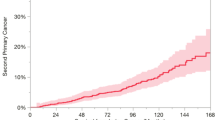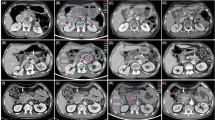Abstract
The management of Pancoast tumors has challenged surgeons and radiation and medical oncologists over several decades. Retrospective studies have raised a greater awareness of the importance of positive N2 lymph nodes in terms of prognosis and treatment decision making. While patients with positive N2 lymph nodes have generally been excluded from trials of preoperative chemoradiation for superior sulcus tumors, the potential of surgery for these patients is still being evaluated. The role of PET for initial staging as well as for assessment of disease response to induction therapy continues to evolve. The use of combined treatment modalities has enhanced the progress in successfully treating Pancoast tumors. The historical data showing improved results with a combination of surgery and radiation compared with surgery alone for patients with positive N2 nodes provides the basis for several important clinical trials that integrate the use of chemotherapy into the treatment paradigm. The Southwest Oncology Group and Japanese Clinical Oncology Group have shown dramatic improvements in complete resection rates following a neoadjuvant course of combined chemotherapy and radiation therapy compared with historical series. We discuss relevant ongoing clinical trials that include consolidative taxane-based chemotherapy and the role of prophylactic cranial irradiation in complete responders. Future potential areas of investigation, including the role of surgery for patients with N2-positive disease and the use of imaging to assess response after induction therapy, are discussed.
Key Points
-
Determining the status of the N2 nodes has important prognostic and treatment decision-making implications
-
Single modality treatments (surgery, radiation therapy, or chemotherapy) for Pancoast tumors have been associated with poor survival
-
Southwestern Oncology Group (SWOG) 9416 was a landmark trial that demonstrated a 5-year overall survival with preoperative chemoradiation
-
A multimodality approach requires close coordination between the radiation and medical oncologists and the thoracic surgeon
-
Additional studies are required to develop better predictors of response to treatments and to design treatment strategies to control distant sites of failure
This is a preview of subscription content, access via your institution
Access options
Subscribe to this journal
Receive 12 print issues and online access
$209.00 per year
only $17.42 per issue
Buy this article
- Purchase on Springer Link
- Instant access to full article PDF
Prices may be subject to local taxes which are calculated during checkout

Similar content being viewed by others
References
Teixeira JP (1983) Concerning the Pancoast tumor: what is the superior pulmonary sulcus? Ann Thorac Surg 35: 577–578
Pancoast H (1932) Superior pulmonary sulcus tumor: tumor characterized by pain, Horner's syndrome, destruction of bone and atrophy of hand muscles. JAMA 99: 1391–1396
Kraut MJ et al. (2003) Pancoast (superior sulcus) neoplasms. Curr Probl Cancer 27: 81–104
Komaki R (1991) Preoperative radiation therapy for superior sulcus lesions. Chest Surg Clin N Am 1: 13–35
Rusch VW et al. (2000) Factors determining outcome after surgical resection of T3 and T4 lung cancers of the superior sulcus. J Thorac Cardiovasc Surg 119: 1147–1153
Weinreb JC et al. (1991) Thoracic magnetic resonance imaging. Clin Chest Med 12: 33–54
Laissy JP et al. (1995) Assessment of vascular involvement with magnetic resonance angiography (MRA) in Pancoast syndrome. Magn Reson Imaging 13: 523–530
Gould MK et al. (2003) Test performance of positron emission tomography and computed tomography for mediastinal staging in patients with non-small-cell lung cancer: a meta-analysis. Ann Intern Med 139: 879–892
MacManus MP et al. (2001) High rate of detection of unsuspected distant metastases by pet in apparent stage III non-small-cell lung cancer: implications for radical radiation therapy. Int J Radiat Oncol Biol Phys 50: 287–293
Vallieres E et al. (2001) Pancoast tumors. Curr Probl Surg 38: 293–376
Anderson TM et al. (1986) Factors affecting survival in superior sulcus tumors. J Clin Oncol 4: 1598–1603
Stanford W et al. (1980) Influence of staging in superior sulcus (Pancoast) tumors of the lung. Ann Thorac Surg 29: 406–409
Martini N et al. (1987) The role of surgery in N2 lung cancer. Surg Clin North Am 67: 1037–1049
Andre F et al. (2000) Survival of patients with resected N2 non-small cell lung cancer: evidence for a subclassification and implications. J Clin Oncol 18: 2981–2989
Albain KS et al. (2003) Phase III comparison of concurrent chemotherapy plus radiotherapy (CT/RT) and CT/RT followed by surgical resection for stage IIIA(pN2) non-small cell lung cancer (NSCLC): initial results from intergroup trial 0139 (RTOG 93-09) [abstract #2497]. Proc Am Soc Clin Oncol 22: 621
Paulson DL (1985) Technical considerations in stage III disease: the “superior sulcus” lesion. In International Trends in General Thoracic Surgery, Volume I, 121–133 (Eds Delarue NC and Eschapasse H) Philadelphia: WB Saunders
Dartevelle PG et al. (1993) Anterior transcervical-thoracic approach for radical resection of lung tumors invading the thoracic inlet. J Thorac Cadiovasc Surg 105: 1025–1034
Grunenwald D et al. (1997) Transmanubrial osteomuscular sparing approach for apical chest tumors. Ann Thorac Surg 63: 563–566
Grunenwald D et al. (1996) Total vertebrectomy for en bloc resection of lung cancer invading the spine. Ann Thorac Surg 61: 723–725
Komaki R et al. (1998) Multidisciplinary approach for the management of superior sulcus tumors. Proc Am Soc Clin Oncol 17: 491a
Chao KS et al. (1999) Radiation Oncology: Management Decisions. Philadelphia: Lippincott-Raven
Hilaris BS et al. (1987) The role of external radiation and brachytherapy in unresectable non-small cell lung cancer. Surg Clin North Am 67: 1061–1071
Martinez-Monge R et al. (1994) Combined treatment in superior sulcus tumors. Am J Clin Oncol 17: 317–322
Ginsberg RJ et al. (1994) Influence of surgical resection and brachytherapy in the management of superior sulcus tumor. Ann Thorac Surg 57: 1440–1445
Dillman RO et al. (1996) Improved survival in stage III non-small-cell lung cancer: seven-year follow-up of cancer and leukemia group B (CALGB) 8433 trial. J Natl Cancer Inst 88: 1210–1215
Curran WJ et al. (2003) Long-term benefit is observed in a phase III comparison of sequential vs concurrent chemo-radiation for patients with unresected stage III NSCLC: RTOG 9410 [abstract #2499]. Proc Am Soc Clin Oncol 22: 621
Chardack WM et al. (1956) Pancoast tumor: five-year survival without recurrence or metastases following radical resection and postoperative irradiation. J Thorac Surg 31: 535–542
Paulson DL (1966) The survival rate in superior sulcus tumors treated by presurgical irradiation. JAMA 196: 342
Martinod E et al. (2002) Management of superior sulcus tumors: experience with 139 cases treated by surgical resection. Ann Thorac Surg 73: 1534–1539
Wright CD et al. (2002) Superior sulcus lung tumors. Results of combined treatment (irradiation and radical resection). Ann Thorac Surg 73: 1541–1544
Maggi G et al. (1994) Combined radiosurgical treatment of Pancoast tumor. Ann Thorac Surg 57: 198–202
Neal CR et al. (1991) Pancoast tumor: radiation therapy alone versus preoperative radiation therapy and surgery. Int J Radiat Oncol Biol Phys 21: 651–660
Komaki R et al. (2000) Outcome predictors for 143 patients with superior sulcus tumors treated by multidisciplinary approach at the University of Texas M.D. Anderson Cancer Center. Int J Radiat Oncol Biol Phys 48: 347–354
Hilaris BS et al. (1974) The value of preoperative radiation therapy in apical cancer of the lung. Surg Clin North Am 54: 831–840
Shahian DM et al. (1987) Pancoast tumors: improved survival with preoperative and postoperative radiotherapy. Ann Thorac Surg 43: 32–38
Schaake-Koning C et al. (1992) Effects of concomitant cisplatin and radiotherapy on inoperable non-small-cell lung cancer. N Engl J Med 326: 524–530
Sause W et al. (2000) Final results of phase III trial in regionally advanced unresectable non-small cell lung cancer: Radiation Therapy Oncology Group, Eastern Cooperative Oncology Group, and Southwest Oncology Group. Chest 117: 358–364
Rusch VW et al. (2001) Induction chemoradiation and surgical resection for non-small cell lung carcinomas of the superior sulcus: initial results of Southwest Oncology Group Trial 9416 (Intergroup Trial 0160). J Thorac Cardiovasc Surg 121: 472–483
Rusch VW et al. (2003) Induction chemoradiotherapy and surgical resection for non-small cell lung carcinomas of the superior sulcus (Pancoast tumors): mature results of Southwest Oncology Group trial 9416 (Intergroup 0160) [abstract]. Proc Am Soc Clin Oncol 22: a2548
Kunitoh H et al. (2003) A phase II trial of pre-operative chemoradiotherapy followed by surgical resection in Pancoast tumors: initial report of Japan Clinical Oncology Group trial (JCOG 9806) [abstract]. Proc Am Soc Clin Oncol 22: a2549
Kwong KF et al. (2005) High-dose radiotherapy in trimodality treatment of Pancoast tumors results in high pathologic complete response rates and excellent long-term survival. J Thorac Cardiovasc Surg 129: 1250–1257
Attar S et al. (1998) Superior sulcus (Pancoast) tumor: experience with 105 patients. Ann Thorac Surg 66: 193–198
Miyoshi S et al. (2004) Induction concurrent chemoradiation therapy for invading apical non-small cell lung cancer. Jpn J Thorac Cardiovasc Surg 52: 120–126
Barnes JB et al. (2002) Concomitant weekly cisplatin and thoracic radiotherapy for Pancoast tumors of the lung. Am J Clin Oncol 25: 90–92
Byhardt RW et al. (1998) Response, toxicity, failure patterns, and survival in five Radiation Therapy Oncology Group (RTOG) trials of sequential and/or concurrent chemotherapy and radiotherapy for locally advanced non-small-cell carcinoma of the lung. Int J Radiat Oncol Biol Phys 42: 469–478
Graham MV et al. (1999) Clinical dose-volume histogram analysis for pneumonitis after 3D treatment for non-small cell lung cancer (NSCLC). Int J Radiat Oncol Biol Phys 45: 323–329
Marks LB et al. (1997) Physical and biological predictors of changes in whole-lung function following thoracic irradiation. Int J Radiat Oncol Biol Phys 39: 563
Kwa SL et al. (1998) Radiation pneumonitis as a function of mean lung dose: an analysis of pooled data of 540 patients. Int J Radiat Oncol Biol Phys 42: 1–9
Hicks RJ et al. (2001) The utility of (18)F-FDG PET for suspected recurrent non-small cell lung cancer after potentially curative therapy: impact on management and prognostic stratification. J Nucl Med 42: 1605–1613
Choi NC et al. (2002) Dose-response relationship between probability of pathologic tumor control and glucose metabolic rate measured with FDG-PET after preoperative chemoradiotherapy in locally advanced non-small-cell lung cancer. Int J Radiat Oncol Biol Phys 54: 1024–1035
Mac Manus MP et al. (2003) Positron emission tomography is superior to computed tomography scanning for response-assessment after radical radiotherapy or chemoradiotherapy in patients with non-small cell lung cancer. J Clin Oncol 21: 1285–1292
Hagan MP et al. (1999) Superior sulcus lung tumors: impact of local control on survival. J Thorac Cardiovasc Surg 117: 1086–1094
Komaki R et al. (1987) Brain metastasis in patients with superior sulcus tumors. Cancer 59: 1649–1653
Visbal AL et al. (2005) Adjuvant chemotherapy for early stage non-small-cell lung cancer. Chest 128: 2933–2943
Gandara DR et al. (2003) Consolidation docetaxel after concurrent chemoradiotherapy in stage IIIB non-small-cell lung cancer: phase II Southwest Oncology Group Study S9504. J Clin Oncol 21: 2004–2010
Author information
Authors and Affiliations
Corresponding author
Ethics declarations
Competing interests
The authors declare no competing financial interests.
Rights and permissions
About this article
Cite this article
Narayan, S., Thomas, C. Multimodality therapy for Pancoast tumor. Nat Rev Clin Oncol 3, 484–491 (2006). https://doi.org/10.1038/ncponc0584
Received:
Accepted:
Issue Date:
DOI: https://doi.org/10.1038/ncponc0584
This article is cited by
-
Current treatment concepts of Pancoast tumors
European Surgery (2010)



